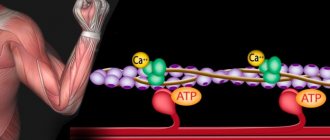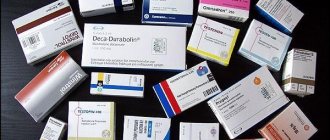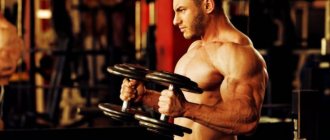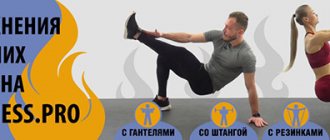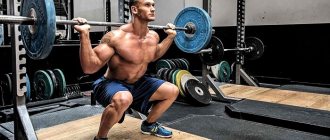Myofibril hypertrophy
Myofibrils are bundles of myofilaments (the contractile parts of the muscle - i.e. those parts that pull and squeeze weight). They are found in all skeletal muscle tissues.
Each muscle cell contains many myofibrils. Myofibril hypertrophy occurs due to increased physical activity (when you lift weights greater than what your body is used to) which leads to damage to individual muscle cells. Your body reacts to this as an “injury” and, when recovering, “compensates with a reserve” for the resulting damage, increasing the volume and density of myofibrils so that the “injury” does not happen again.
This is one of the reasons why, in order to continue to achieve results, you need to subject your body to ever-increasing stress. In the photo below you see the structure of muscle fiber.
How muscles grow: intermediate fibers
In recent years, scientists have identified another type of muscle fiber - intermediate. This means that they have less myoglobin and mitochondria than slow (red) muscle cells, but slightly more than white muscle cells. An important feature of intermediate fibers is that during training they acquire the characteristics of fibers of the first or second type, helping to adapt to a certain load.
It is believed that every person is born with a predominant type of muscle tissue. In other words, there is a hereditary predisposition to a certain sport. That is why one person is good at running cross-country, while another is good at lifting weights. Although regular exercise can slightly equalize the quantitative ratio of fiber types, this will not change the overall picture.
A story about the structure of muscle tissue would be incomplete without mentioning fascia . Myofibrils form bundles that are covered with a kind of case, this is the fascia. In some people, it is softer and filled with a large number of capillaries, and therefore does not interfere with muscle growth. For others, on the contrary, it is quite tough, and it is more difficult to gain muscle mass.
Sarcoplasmic hypertrophy
Sarcoplasm is the fluid that surrounds myofibrils in muscles and is a source of energy. It contains such “things” as ATP, glycogen, creatine phosphate and water.
Sarcoplasmic hypertrophy generally occurs in the same way as myofibrillar hypertrophy. The body, during the recovery period after the depletion of your energy reserves, “compensates with a reserve” for what was lost. Thus, the amount of energy reserves - such as ATP and glycogen - is increased in order to subsequently prevent their rapid depletion.
An increase in the size of the blood vessels that "deliver" blood to the muscles can also be included in sarcoplasmic hypertrophy. This phenomenon is often called capillarization.
So now you know the two types of hypertrophy. What's the best way to achieve both of them? Before answering this question, I would like to emphasize: match the weights to the number of repetitions, NOT the number of repetitions to the weights.
Progressive overload means gradually increasing the load on the muscle as it becomes stronger or more resilient. This means that you need to use weights and repetitions that will be very difficult to overcome.
You need to choose exactly the weight with which you can barely do the required number of repetitions. Do not take weights with which you cannot do the required number of repetitions or, conversely, at the end of the set you will be able to do many more repetitions. Therefore, if you need to do 12 repetitions in an exercise, choose a weight with which you can do exactly 12 repetitions.
What stimulates muscle growth
It's time to talk about what stimulates muscle growth. It is unlikely that anyone will argue with the fact that the male hormone testosterone has a powerful anabolic effect. Many bodybuilders, imitating the example of overseas stars, use “pharma” - anabolic steroids. These are synthetic analogues of natural testosterone and pose a serious health threat. First of all, the liver and thyroid gland are affected, and with constant use, erectile function decreases.
Meanwhile, our country has developed a safe sports supplement, Leveton Forte, which stimulates muscle growth. It is created only from natural ingredients, such as Leuzea safflower root, drone brood and bee pollen. It has been confirmed by research that drone brood contains a large amount of testosteroid hormones and acts as a stimulator of the central mechanisms for regulating the intensity of androgen formation .
Thanks to well-chosen ingredients, Leveton Forte is an excellent assistant for those who want to build muscle and maintain health. In addition to the anabolic effect, it has anti-catabolic properties and also strengthens the immune system.
We reviewed several concepts that describe muscle growth and described the structure of muscle tissue. It turned out that there is no agreement among researchers on this topic yet. What is clear is that strength training causes an increase in the cross-sectional area of the muscle fiber. It turns out that the question of what causes muscles to grow requires further development.
Myofibril hypertrophy training
Strength training with weights of 80% or more of your one-rep maximum. 3-8 repetitions with pauses between sets of 2-4 minutes. Such a system will ensure a maximum increase in the volume and saturation of myofibrils. This means that if you want to achieve myofibrillar hypertrophy, you need to lift heavy weights. The more weight, the more muscle fibers are used, and therefore damaged. However, it is recommended to stick to 3-5 repetitions per set, as fewer results in more neuromuscular adaptations, which mainly develop strength.
In fact, low reps are critical for maximum growth.
How do hormones affect muscle growth?
Hormones are another important factor that significantly influences muscle growth and recovery, as hormones regulate the activity of myosatellites. Insulin-like growth factor IGF-1, in particular mechanical growth factor (MGF) and testosterone are the main mechanisms for activating muscle growth.
Testosterone increases protein synthesis, inhibits their destruction, activates myosatellites and stimulates other anabolic hormones. The vast majority of this hormone in the body is unavailable for use (up to 98%), but during strength training not only testosterone is released, but also the sensitivity of muscle cells to it increases. Testosterone also stimulates the growth hormone response by increasing the presence of neurotransmitters at sites of damaged muscle fibers, which also helps stimulate muscle tissue growth.
Insulin-like growth factor regulates muscle growth by stimulating protein synthesis, promoting glucose uptake and redistribution of amino acid uptake (the building blocks of protein) in skeletal muscle, and also activates satellite cells to intensify muscle growth.
Training for sarcoplasmic hypertrophy
Sarcoplasmic hypertrophy is achieved through so-called endurance training. The weights taken are approximately 75% of those that you can do at one time, and the number of repetitions is 10-15. The pause between sets is 45-90 seconds. This is called endurance training because it uses up large amounts of energy in the muscle cells very quickly, depleting the muscles.
When choosing the number of sets for such workouts, you need to take into account the amount of time spent under load. There is a minimum amount of time that must be spent under load to achieve hypertrophy. And for endurance training this time is longer than for strength training.
In endurance training, the time under tension should be greater than the reserves of energy available for expenditure. The main sources of energy for anaerobic exercise are ATP and creatine phosphate. They are short-lived and deplete after 7-10 seconds. After this, your body resorts to glycogen stores, which in turn causes the release of lactic acid (this is what causes a burning sensation in the muscles). This means that in endurance training, the time under load should exceed 10 seconds. This in turn means that performing slow reps and supersets is a great way to achieve sarcoplasmic hypertrophy.
Myofiber hyperplasia in oxidative muscle fibers
The technique for myofibrillar hyperplasia in the OMV (MMH) is similar to the previously described technique for the HMV. The main distinguishing condition is the requirement to perform the exercise without relaxing the muscles being trained. In this case, tense and thickened MVs compress the capillaries (Physiology of Muscular Activity, 1982), causing occlusion (circulatory arrest). Impaired blood circulation leads to hypoxia of the MV, i.e., anaerobic glycolysis in the MV is intensified, lactate and H2 accumulate in them. Obviously, such conditions can be created when working against gravity or the traction of a rubber shock absorber.
Let's give an example of such an exercise. Squats are performed. A person from the deepest squat gets up to an angle in the knee joints of 90–110°:
— intensity — 10–40%;
— exercise duration — 30–60 s (failure due to muscle pain);
— rest interval between approaches — 5–10 minutes. (rest should be active);
— number of approaches to the projectile — 7–12;
— number of workouts per day: one, two or more;
- number of workouts per week: the exercise is repeated after 3-5 days.
The rules can be justified as follows. The intensity of the exercise is chosen such that only MMVs are recruited. The duration of the exercise should not exceed 60 s, otherwise the accumulation of H may exceed the optimal concentration to activate protein synthesis. To increase the time spent in OMV K and N, you should perform the exercise in the form of a series of approaches, namely: the first approach not to failure (30 seconds), then a rest interval of 30 s. This is repeated three or five times, then a long rest is performed or another muscle is exercised. The advantage of such an exercise (in bodybuilding it is called a “super series”) is that Kr and H are present in the OMV both during the exercise and during rest pauses. Consequently, the total time of action of factors (Kr, N) causing the formation of RNA increases significantly in comparison with the previously described training options.
One important note should be made. Training aimed at increasing protein synthesis should be carried out at the end of a training session and preferably during an evening workout. The fact is that in response to strength training, protein molecules are formed; If, after strength training, a long workout with high oxygen consumption is performed, then when glycogen reserves are depleted, proteins will be intensively metabolized, which will ultimately lead to a decrease in the effectiveness of the workout.
Methods for hyperplasia of myofibrillar mitochondria
The goal of aerobic training is the development of mitochondria in muscle fibers. Mitochondrial protein is synthesized 85–95% in the cytoplasm and only 5–15% of the protein content is a product of mitochondrial translation itself (Leninger A., 1966; Luzikov V.N., 1980).
Proteins synthesized on mitochondrial ribosomes are incorporated into the inner mitochondrial membrane. The outer membrane, intermembrane space and matrix are completed with proteins produced on cytoplasmic ribosomes. Swelling of mitochondria is one of the manifestations of their degradation. The cause of mitochondrial swelling may be (Luzikov V.N., 1980; Schmeling et al., 1985; Friden et al., 1988; Gollnick et al., 1986) disturbances in energy transformation (for example, due to the depletion of endogenous substrates, suppression of electron transfer , when changing the permeability of the inner membrane with respect to hydrogen ions). It is assumed that the depletion of the intramitochondrial ATP supply causes swelling of the mitochondria, which leads to rupture of the outer membrane and the spreading of components into the intermembrane space. There is a natural aging of mitochondria and its individual components (half-life - from 1 to 10 days). The formation of mitochondria in a cell is controlled based on the principle of selection according to a functional criterion. According to this principle, mitochondrial structures, assembled in such a way that they cannot effectively transform energy, are eliminated during mitochondrial differentiation (Luzikov V.N., 1980).
One of the natural factors leading to the destructuring of mitochondria is hypoxia (for example, staying in mid-altitude areas) and the accompanying anaerobic metabolism. Under conditions of oxygen starvation, capillarization rates of skeletal muscles worsen, intracellular edema appears, focal disturbances of the contractile (myofibrillar) apparatus, destructive degenerative changes in mitochondria, expansion of the sarcoplasmic reticulum and a sharp decrease in glycogen content (Schmeling et al., 1985)
Similar structural changes occur during glycolytic training.
Summarizing the provisions of numerous studies allows us to make the following generalization:
— mitochondria are the energy stations of the cell, suppliers of ATP due to aerobic metabolism;
— synthesis exceeds the breakdown of mitochondria in the case of their intensive functioning (oxidative phosphorylation);
- mitochondria tend to form in those places of the cell where an intensive supply of ATP energy is required;
— increased destruction of mitochondria occurs under conditions of intensive cell functioning with the involvement of anaerobic metabolism, causing significant or long-term (as in high-altitude conditions) accumulation of hydrogen ions in the cell and in the body.
In accordance with these provisions, it is possible to develop a method of aerobic muscle training.
Each skeletal muscle can be roughly divided, for example, into three parts:
- regularly activated - those muscle fibers that are activated in everyday life (OMV);
— activated only under training conditions close to the power of middle distance running (MDR);
- rarely activated - are activated only when performing maximum efforts, for example, when performing jumps, sprints (GM).
Muscle fibers that are regularly recruited (RMF) with their maximum firing frequency have the maximum degree of aerobic fitness. The maximum degree of aerobic fitness of the muscle fiber is achieved when all myofibrils are intertwined with the mitochondrial system so that the formation of new mitochondrial structures becomes impossible. This phenomenon is well demonstrated for myocardiocytes (Physiology and pathophysiology of the heart, 1990; Hoppeler G., 1987). Myocardiocyte hypertrophy is not accompanied by an increase in the concentration of aerobic metabolic enzymes. Indirectly, this point of view is confirmed by numerous studies devoted to the influence of aerobic training performed with power up to the aerobic threshold (Aulik I. A., 1990; Zatsiorsky V. M., 1970; Karpman V. L., 1974, 1978, 1982, 1985, 1988, etc.). All these studies convincingly show that the effectiveness of such training for already trained athletes is zero.
Therefore, to increase the aerobic capabilities of the MV, it is necessary to create a structural basis for new myofibrils in the MV; after this, new mitochondrial systems are formed near the new myofibrils. If we agree with this method of increasing aerobic capacity, then an increase in the strength (hyperplasia of myofibrils) of the OMV should lead to an increase in oxygen consumption at the level of AeP and AnP.
Continuous exercise at the AnP level or a repeated method of training with power work at the VO2max level are effective for increasing VO2 max or oxygen consumption at the ANP level. In this case, both PMVs and higher-threshold PMVs, which contain few mitochondria, are recruited. An increase in power requires the recruitment of increasingly high-threshold MUs, in which anaerobic glycolysis predominates in the MV, which leads to acidification of the MV, and then the OM and blood. Acidification of HMV and PMV leads to destructive changes in mitochondria and a decrease in the effectiveness of aerobic training.
Theoretically calculated mitochondrial changes under the influence of anaerobic glycolysis products coincide with those observations that occur during ischemia (Friden, 1984; Hoppeler N., 1986). In this case, numerous abnormal mitochondria were visible beneath the sarcolemma. These mitochondria have increased density, altered shape, and paracrystalline inclusions. Crystalline inclusions in mitochondria are found in various pathological conditions (see, for example, review by Carpenter and Karpati, 1985). This suggests that structurally damaged cells cannot function normally. Polyribosomes are located either under the sarcolemma or next to damaged myofibrils; their participation is assumed in the process of reconstruction of damaged material. The authors conclude that frequent use of this training option can lead to serious muscle damage.
One of the arguments against the proposed method of increasing the aerobic capabilities of the MV due to an increase in strength (MF) is the opinion: with an increase in the size of the MV, the process of diffusion of O2 to the center of the MV becomes more difficult. However, studies by T. Gayeski ea (1986) showed that pO2 does not correlate with the diameter of the MV. The minimum pO2 is not observed in the center of the MV. These experimental data are well reproduced by models that take into account the facilitated diffusion of oxygen into the MV through myoglobin (R. Stroeve, 1982). Consequently, the size of the MV is not an obstacle to the growth of the aerobic capabilities of the MV.
The rules of the aerobic training technique can be presented as follows:
— intensity: corresponds to the power of the AnP;
— duration: 5–20 minutes, longer duration can lead to significant acidification of the blood and PMV if the specified power is exceeded;
— rest interval: 2–10 minutes, necessary to eliminate possible acidification of the body;
— the maximum number of repetitions in training is limited by glycogen reserves in active muscles (approximately 60–90 minutes of pure training time);
- training with maximum volume is repeated after 2-3 days, i.e. after glycogen resynthesis in the muscles.
The variant of aerobic training, which has recently become widespread in the practice of training athletes in cyclic sports, is highly effective. These are workouts that require “muscular endurance.” Their meaning is that in a cyclic exercise, each muscle contraction should be performed with near-maximal intensity, but the average power of the exercise should not exceed the power of the AnP. In this case, all MVs are active in the exercise, however, by controlling the rest pause or the period of muscle relaxation, the elimination of metabolic products of anaerobic glycolysis should be completely ensured.
Exercises with near-maximal muscle contraction power and a slow pace were studied by J. Karlsson ea (1981). It has been shown that exercise at a rate of 4 maximum contractions per minute causes a decrease in the concentration of ATP by 20%, CrP by 40%, and the lactate concentration in the muscle increases to 4.5 mmol/l. Overall, the exercise was aerobic, with energy coming from endogenous glycogen OMV and HMV.
An increase in aerobic capacity can occur on the basis of an increase in the strength of the muscle fiber, i.e., you can engage in static-dynamic exercises for hyperplasia of myofibrils in the muscle fiber, and at the same time processes will unfold to provide new myofibrils with new mitochondria. This assumption is confirmed by the results of experiments by S. K. Sarsania (1972).
IFC student volunteers were divided into two groups: experimental and control. Both groups performed the same strength exercise program with muscle tension 60% of the voluntary maximum (RM). Exercises were performed in a circle (circuit training) on the arm extensors, arm flexors, leg extensors, back extensors, and abdominal muscles. In each approach, the load was slowly lifted 10 times, the last two times were performed with obvious local fatigue, but not to failure. Each subject completed three laps. There were 3 training sessions per week, we trained for 4 weeks. The experimental group (8 people) took anabolic drugs (ritobolil or neurobol) at 0.18 mg/kg body weight (therapeutic dose). The control group received a placebo in the form of a vitamin complex.
Before and after the experiment, all subjects underwent anthropometric and functional testing in a step test with determination of oxygen consumption.
In the control group, changes occurred in all indicators, but the significance of the differences was less than 90%. The use of anabolic drugs accelerated the course of anabolic processes, which made it possible to obtain statistically significant differences (P>99%) for all registered indicators. The most interesting results include:
1) Increase in strength of all muscle groups by 25%, which was 2% per session. When strength training occurs without the use of stimulants, the average increase is 1.0–1.2% per workout. Lean mass increased by 3.55 kg.
2) Reduction in total fat mass by 0.88 kg. Stress stimulates the release of pituitary hormones into the blood and activates the sympathetic nervous system. As a result, the release of adrenal medulla hormones (catecholamines) - adrenaline and norepinephrine (norepinephrine is also released from the endings of the sympathetic nervous system) begins. These hormones, as well as testosterone and somatotropin, stimulate the release of fatty acids from fat depots into the blood. An increased concentration of hormones and polyribosomes is retained in body tissues for 1–2 days, which increases basal metabolism and the use of fatty acids from fat depots for the functioning of the heart, respiratory muscles and plastic processes in skeletal muscles.
3) Oxygen consumption (MOC) increased by 0.231 ml O2 and power at pulse 170 beats/min by 22.7 W (136 kgm/min). The increase in oxygen consumption (MIC) and power of PWC-170 confirms the previously stated assumption that with an increase in the strength of OMVs, i.e. with an increase in the number of myofibrils in them, morphological prerequisites are created for the growth of all organelles necessary for cell activity (theory of symmorphosis) , therefore the sarcoplasmic reticulum and mitochondria increase. The change in the latter was recorded in the form of an increase in MIC and power of PWC-170.
Thus, statodynamic exercises are an effective means of enhancing plastic processes in skeletal muscles. The use of anabolic drugs in therapeutic doses significantly intensifies anabolic processes, which speeds up testing the effectiveness of the developed variants of the training process; static-dynamic exercises stimulate protein metabolism, fat metabolism, and increase the aerobic capabilities of slow muscle fibers.
The totality of changes as a result of the use of static-dynamic exercises gives grounds for the assumption that their use in health-improving physical culture is highly effective.
